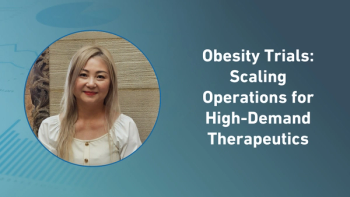
Identifying Clinical Trial Diversity Goals With Imperfect Data
In this video interview, Rachael Fones, director, government & public affairs, IQVIA, highlights the use of real-world data in setting population goals.
In a recent interview with Applied Clinical Trials, Rachael Fones, director, government & public affairs, IQVIA, discussed the importance of diversity action plans in clinical trials. Fones emphasized the need for understanding the intent behind goal setting, the ability to stay updated with FDA guidelines, and the importance of a robust population assessment.
ACT: How can sponsors confidently set diversity goals for trials with imperfect data?
Fones: Setting goals and finding the data to do it—I mean real-world data, especially, has so much value, so much value to planning and is so important, and there's growing sources and value in the real-world data. At the end of the day, though, data on population goals is not something you just pull from a database. It's not something that will ever be perfect and exact to your population, so we have to remember, that real-world data provides great insights, but it informs, it doesn't necessarily answer what your goals should be.
One of the things we've seen in our conversations with sponsors, and also in the broader conversation among advocates and industry, and my peers across other organizations is there's consternation around the data; how do you find the population data? Goal setting based on real-world data, based on epidemiology data and public data sources, it's widely acknowledged that these data sources are imperfect, often not granular enough to get to the specifics of your intended use population. While this is something we need to continue to pursue and improve data sources and improve techniques, I think that it's important to realize that real-world data will inform your goals. It's not going to answer your goals. That needs to be that full exploration of the data in the context of the disease, in the context of your trial, but we also need to think about it's understandable that sponsors and individuals within sponsor teams may feel some consternation in moving forward with imperfect data. Setting a goal, committing to a number with a regulator is intimidating, especially if you're concerned you can't reach that goal. On top of that, you look at enrollment sub-goals and enrollment in a trial where you're already worried about getting that complete is also concerning. What we help sponsors do, and often do, is really talk about them understanding that this isn't a pass or fail exercise. It's not what is the answer from this the data that that is the perfect answer, and then how do we get there and what happens if we don't? It's really about understanding that population, understanding those characteristics, setting a goal that is meaningful in context of that disease burden and differences in outcomes; meaningful, but yet achievable, and that's where really understanding the real-world data in context of your use population. If it's pre-metastatic, but second-line therapy, that is a bit of a difference from all breast cancer, for example.
Again, real-world data informs, but it doesn't answer it. Diversity and that population is specific for your disease area and for the trial, so what really is important is the ability to look at different queries, understand what that story might be, what the rationale should be to setting those goals. Then, the final piece of this is we all need to realize there's going to need to be some flexibility in learning as we go along. We can think that population looks like what it is, but there may be some learnings as you go along that perhaps that genetic marker, that for which there wasn't a lot of real-world data, maybe it has an outsized effect, actually, maybe it makes your population more available. The goal here, if we think back to the goals of diversity overall, again, it's not just about increasing participation and access to the trials, though, very important. It is about learning and feeding back. If we learn that one genetic marker impacts one race differently or more prevalently, that not only helps you develop your drug better, but it helps advance the science, advance the practice of medicine, and advance new therapies. I think also the more that sponsors and all of us in drug development see where some differences do and do not come into play, that this whole effort will not seem so foreign. It will become an important part of drug development and pay that benefit that that upfront exploration yields better trials, faster trials even, and more commercial and healthcare success.
Newsletter
Stay current in clinical research with Applied Clinical Trials, providing expert insights, regulatory updates, and practical strategies for successful clinical trial design and execution.





.png)



.png)



.png)
.png)
